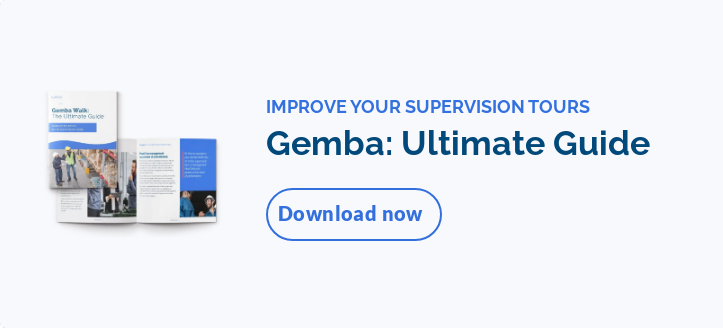What is Quick Response Quality Control?
Quick Response Quality Control is a structured, rapid, pragmatic approach to problem-solving mainly used in manufacturing. QRQC aims to detect, analyze, and correct quality defects in real time, minimize their negative impact, and continually improve the production process.
This method draws heavily on the principles of various Japanese Lean Management methods, such as Toyota Production System (TPS), Kaizen, and Lean Manufacturing.
In the 90s, the automotive industry faced increasing competition, requiring constant product quality improvement and reduced production lead times. In response to this problem, Nissan is developing the QRQC concept to improve responsiveness and better manage quality problems in its processes. Shortly afterward, the Valeo Group, an automotive supplier, adopted and enhanced this management approach.
Key benefits of the QRQC method for manufacturing companies:
- Faster reaction to problems
- Improved product quality
- Involvement and empowerment of teams
- Optimization of operational processes
- Prevention of future defects
- Efficient use of data
- Reduction of non-quality costs
- Better use of resources
- Greater customer satisfaction
QRQC tools and techniques
Gemba Walk: Direct observation on the field
Gemba refers to the workplace (where value is created), such as the shop level or manufacturing site. Gemba Walk is a practice where team leaders go into the field to directly observe processes, identify problems, and discuss solutions with operators. It echoes the principle of San Gen Shugi, which advocates observing the three realities: Gemba (the real place), Genbutsu (the real objects), and Genjitsu (the real facts).
- Enables precise and immediate understanding of problems.
- Promotes transparency and engagement.
- Reinforces employee involvement by giving them a voice in the improvement process.
Ishikawa diagram: Cause and effect analysis
This visual tool, also known as the “fishbone diagram”, is used to identify the potential causes of a specific problem. Its structure is reminiscent of a fish skeleton, with the effect (the problem) at the head and the categories of possible causes along the edges.
- Simplifies root causes identification.
- Encourages a structured, collaborative approach to problem-solving.
- Allows complex problems to be dealt with effectively by breaking them into manageable elements.
PDCA cycle: Continuous improvement
The PDCA cycle (Plan-Do-Check-Act) is an iterative management method for controlling and continuously improving processes and products.
- Encourages a structured, systematic approach to continuous improvement.
- Facilitates experimentation and learning by doing.
- Enables rapid, iterative adjustments to be made according to the results obtained.
UTrakk: Performance management and monitoring
UTrakk is a Daily Management System (DMS) for performance management and continuous improvement in manufacturing and industrial environments. It lets you manage problems efficiently, coordinate corrective actions, and track continuous improvement indicators.
- Accelerates identification of variances through dashboards, floor tours, audits, and checklists.
- Centralizes data, rituals, actions, opportunities, and projects supporting the management of your performance axes – quality, productivity, safety, etc.
- Enables real-time tracking of actions, projects, and results, ensuring in-depth analysis, effective adjustments, and continuous improvement.
6 Steps to implement the QRQC method
Quick Response Quality Control meetings play a crucial role in implementing this method. They are structured daily meetings focused on continuous improvement. They enable workers to examine the steps required to implement the QRQC process successfully. They involve all levels in the management hierarchy, especially support departments.

1. Quick quality issue identification
Any problems detected are reported as soon as they occur and discussed in the QRQC meeting. It may include production faults, non-conformities, or deviations from established quality standards.
Tips
- Ensure all team members are trained to recognize and report quality problems immediately.
- Implement automated inspection systems to identify anomalies quickly.
2. Direct floor observation
Go directly to where the problem has been detected to observe the facts and collect real data. The information gathered is then shared during the QRQC meeting, enabling employees to benefit from real-time feedback.
Tips
- Encourage managers to conduct regular Gemba Walks with operators to foster communication and collaboration.
- Use tools such as tablets or smartphones to document observations on the spot in real-time.
3. Cause analysis
Use cause analysis tools, such as the 5 Whys or the Ishikawa diagram, to quickly identify the root cause of the problem.
Tips
- Organize analysis sessions with teams from multiple departments to obtain varied, in-depth perspectives.
- Record all stages of the analysis for future reference and to strengthen the company's knowledge base.
4. Implementation of immediate countermeasures
Corrective measures are discussed and decided at the QRQC meeting to ensure rapid, concerted implementation. The active participation of all members ensures that clear actions are defined and everyone involved takes responsibility.
Tips
- Prioritize corrective actions that are easy to apply and deliver rapid results.
- Use a Daily Management System such as UTrakk to track the progress and implementation of corrective actions.
5. Result monitoring and assessment
The results of applied corrective actions are monitored and evaluated during the QRQC meeting to ensure the problem has been resolved sustainably.
Tips
- Define Lean KPIs to measure the effectiveness of corrective actions.
- Gather regular feedback from operators and production teams to adjust actions if necessary.
6. Documentation and knowledge sharing
Document each problem, the analysis carried out, the corrective measures implemented, and the results obtained.
Tips
- Use quality management software to centralize and organize all information.
- Hold regular meetings to share lessons learned and best practices with all teams.
Example of QRQC in a factory
An automotive parts manufacturing plant has noticed an increase in defects on a specific production line, which is leading to frequent customer returns for faulty parts.
Application of QRQC
- Rapid problem identification: Production line operators immediately report detected defects using a visual alert system.
- Direct observation: Production managers visit the production line to observe faults first-hand and discuss them with operators.
- Root cause analysis: An analysis workshop is organized, using the 5 Whys and the Fishbone Diagram to determine that the defects stem from poor calibration on a machine.
- Corrective action: The machine is recalibrated, and regular verification protocols are established to ensure correct calibration.
- Result monitoring and assessment: Managers track defect rates over several weeks and see a significant reduction in defects.
- Documentation and knowledge sharing: The resolution process is documented and shared at meetings to prevent similar problems from recurring.
Results
- Reduced defect rates
- Improved customer satisfaction
- Savings on returns and rework costs
Quickly solve problems and improve your operational efficiency
Fewer problems = greater efficiency. The formula is obvious.
QRQC enables manufacturers to react quickly and effectively to quality problems. It contributes to product improvement and customer satisfaction, engages teams, and boosts overall process efficiency.
Daily QRQC meetings, combined with practices such as PDCA and Ishikawa diagrams, ensure rapid defect detection, in-depth root cause analysis, and immediate corrective action implementation. It creates a positive dynamic of continuous improvement and responsiveness within the entire company.
The UTrakk solution plays a critical role in this process, offering a tailor-made solution for real-time performance management and monitoring. By integrating this tool, organizations can improve their ability to deal with problems quickly while capitalizing on lessons learned to prevent future challenges.
So, for any manufacturer seeking to remain competitive in a highly demanding environment, implementing QRQC supported by tools like UTrakk DMS is a key strategy and springboard to operational excellence .










